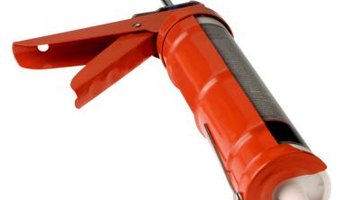What Type of Caulking Should You Use on Nail Holes in PVC Paneling?
Polyvinyl chloride, or PVC, panels can be used indoors or out. PVC panels can be cut and worked like wood but are not affected by moisture and do not require painting. PVC panels and lumber are made of cellular PVC, which is filled with tiny air bubbles that make it flexible and relatively lightweight. The panels can be affixed to studs or other surfaces with nails, like their wood counterparts. And just like wood, when nail heads are countersunk for a clean, finished look, they need to be patched with caulking or filler.
PVC Panel Applications

PVC panels are often used in bathrooms as shower and tub surrounds as well as in exterior applications, like fencing and large expanses of contrasting trim on home exteriors.
Options
Several types of products can be used to fill nail holes in PVC panels. Acrylic or polyurethane caulk is recommended, though latex acrylic caulk is primarily for indoor applications. Polyurethane caulk is a toxic substance, according to the Fine Homebuilding website and should be avoided indoors except in high-traffic areas and areas exposed to harsh weather conditions. Recommended alternatives to either type of caulk for filling nail holes in PVC include vinyl paste or two-part epoxy putty.
What to Avoid
Silicone caulk cannot be used with its PVC panels or other PVC lumber products as it does not adhere well to the PVC, according to The Family Handyman website and PVC lumber manufacturers.
How to Fill a Nail Head
Cut the tip from the caulk tube at an angle. Squeeze a small amount of caulk from the tube into the nail hole, overfilling it slightly. Wipe the caulk off flush with the panel with your gloved finger, a rag or a putty knife. Ensure no caulk remains on the surface of the panel. When using a two-part epoxy nail-hole filler, knead a nickle-sized amount of the putty-like substance until its two colors are thoroughly mixed. Pinch off a tiny amount and roll it between your index finger and thumb. Press the elongated bit of epoxy into the nail hole, ensuring the hole is filled all the way down, not just at the surface. It can be wiped flush in the same manner as the caulk or sanded after it dries.
References
Writer Bio
Patricia Hamilton Reed has written professionally since 1987. Reed was editor of the "Grand Ledge Independent" weekly newspaper and a Capitol Hill reporter for the national newsletter "Corporate & Foundation Grants Alert." She has a Bachelor of Arts in journalism from Michigan State University, is an avid gardener and volunteers at her local botanical garden.
Photo Credits
- Brand X Pictures/Brand X Pictures/Getty Images
More Articles



